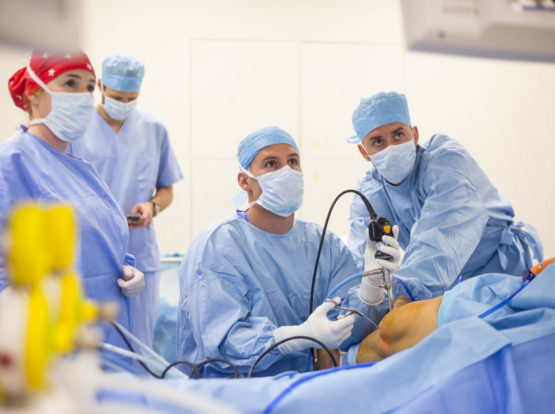12 June 2019
12 June 2019
Can nuisance pain in the knee be a consequence of chondromalacia of the patella? What exactly does this mysterious term mean? What other problems do “knee patients” face? What methods are used to treat patellofemoral joint pathology? Doctor Lukasz Luboinski, orthopedist and traumatology specialist at Carolina Medical Center, answers these and other questions.
The most frequent knee pathologies occur between the patella and the femoral bone. As many as 80 percent of "knee patients” are people with problems around the patella.
Very often patients complaining about annoying pain in the area of the knee suspect chondromalacia of the patella. This is a mistake! It is an anachronism defining all sorts of pain of the anterior knee compartment. Meanwhile, patellar problems and pain are not always associated with the so-called chondromalacia, i.e. degenerative changes. It may be a completely different disease called lateral supra or increased lateral patella suppression - says doctor Łukasz Luboiński from the Carolina Medical Center.
The patella (kneecap) is the most anterior part of the knee. Its pathologies can be divided into three groups. The first group is traumatic changes and instability (dislocation) of the patella. The problem concerns teenagers between 12-16 years of age, when the first dislocation occurs. The cause of such dislocation is genetic predisposition to this type of injury.
The second group includes changes related to the malfunction of the kneecap (not related to instability). They occur in people aged 20-30 and lead to overload as a result of poor sports activity or inappropriate training habits.
Both diseases may or may not lead to cartilage damage on the kneecap.
The third group includes degenerative changes, where cartilage losses occur, and thus the real 4th degree chondromalacia of the knee, i.e. the complete disappearance of the cartilage, when only the bare bone is left. This is a problem that affects people between 40 and 50 years of age” - explains doctor Lukasz Luboinski. Can this be prevented? “If we diagnose these changes early enough and undertake surgical treatment, which would be changing of patellar fraction, changing its position in the patellofemoral joint, further degeneration can be avoided - adds the doctor.
Treatment depends on what is the causative factor, what is the pathology and what changes and abnormalities occurred within the knee. We need to treat what caused the degeneration of cartilage, which is what led to the loss of the kneecap.
Cavities of the kneecap associated with instability and dislocation (in young people) require intervention and surgical treatment leading to changing the position of the patella. We need to strengthen the patellar ligament, which stabilizes the patella, or change the geometry of the joint, or create a new furrow. This is the place where the kneecap slips. The third solution is the bone displacement, i.e. osteotomy, where the position of the patella is changed or reversing the mechanisms that caused it to dislodge.

The most common ailments of the patellofemoral joint are lateral patella support and knee pain syndrome caused by abnormal traction of the kneecap, wherein there is no dislocation. In these patients the first step in the treatment is rehabilitation. It brings great results in as many as 85 percent! Rehabilitation involves changing the work of the muscles, reeducation of the lower limb muscles. The patient works under the watchful eye of a physiotherapist. Exercises are aimed at increasing the activity of the medial head of the quadriceps muscle, stretching the iliac-tibial cord, the lateral head of the quadriceps, and also on stabilizing the pelvis. Doctor Luboinski emphasizes that the rehabilitation program is based on exercises only. There is no room for physical therapy, i.e. iontophoresis, ultrasound or laser. It's an anachronism. Simply exercises are the key to improvement. The patient performs them under the watchful eye of a physiotherapist, but also independently. The goal is to stretch specific muscle groups, strengthen and adjust the patella.
And which treatment method will be suitable for patients with chondromalacia of the patella, i.e. for those who already have degenerative changes and cartilage defects on the kneecap? The effects of improvement, and thus reduction of pain may be brought by arthroscopy. Intraarticular injections are an immediate alternative. They reduce friction and have analgesic effect. However, cartilage defects on the kneecap are irreversible.
We cannot undo the changes that have already occurred in cartilage. However, we can stop them and prevent their further development - says doctor Łukasz Luboiński.
As a result of surgical treatment, further degeneration can be avoided.
À la carte menuIn the treatment of patellofemoral joint pathology the principle of à la carte menu applies.
We choose an individual, optimal solution for each patient. We are able to navigate between difficult operational techniques requiring changes in rotation, changing the angle of the bones. Effective treatment is to choose the most appropriate method. For a patient with patellofemoral pathology we select 2 or 3 most important elements that we can adjust in a safe and predictable way. We want the patient to be able to return to activity and efficiency as soon as possible - says doctor Luboiński.
In conclusion, the spectrum of surgical procedures is enormous: from simple arthroscopy through reconstruction of ligaments, complicated osteotomy and complete change of the axis of the limb. Some patients return to full pre-operative activity. There are also those who can boast a higher and better activity than the one before surgery. It all depends on the degree of previous dysfunction and the type of surgery performed. An important factor is also the lifestyle of the patient. Rehabilitation is also crucial in full return to fitness. It takes about 12 months.